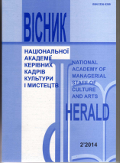PREMARITAL INTERCOURSE UKRAINIAN GIRLS IN YOUTH COMMUNITIES: XIX – XX centuries
DOI:
https://doi.org/10.32461/2226-3209.2.2014.137965Keywords:
culture, customs, traditions, songs, premarital intercourse, youth groups, and loveAbstract
Describe the features of the process of socialization of girls in youth communities XIX – early XX century. We
examined the practices of premarital intercourse Ukrainians, in which the remains of archaic traditions, which administers the whole system of ritualized etiquette and codes of conduct.
On the basis of traditional Ukrainian consumer culture, youth meeting, which lasted until the early twentieth century. Occurred in the form of streets that commence from Easter and lasted until the fall, evening sessions, held from autumn to spring, and the break of day. The difference between the last of the evening sessions was only because they lasted longer – until dawn, hence the name.
All these meetings were some regional differences, in particular, on some evenings longer worked for others – mostly fun. The common feature for all evening sessions was their erotic connotation. Party going girls and boys who have reached the age of marriage organized in Girl and boys'. Party was common custom of "trial marriage", with a choice of steam carried freely and nowhere oblige. Young people in most regions ofUkraine1 – the beginning of the twentieth century. Was relatively independent, solving the problem of creating a family. Today, researchers are paying increasing attention to the development of the taboo in Soviet times, the problem – the manifestation of sexual freedom Ukrainian women.
Of course "tolerance" against unauthorized love that definitely sounds only humorous and obscene songs, proverbs and sayings that can not be interpreted unambiguously. Well-known folk customs daub tar target girls who lost their virginity. Not so tolerant as the humorous songs, was the attitude of sinful love life in reality, although the degree of severity of punishment for immoral behavior was different in different regions ofUkraine. This system, which was marked by the flexibility and freedom of manners, creating a favorable environment for the manifestation of feelings of love. An important aspect of this song is that the girl, turning to her lover, calls him a friend. It definitely motif of gender equality in love, characteristic of Ukrainian folk song. Ukrainian folk love songs often have the form of a dialogue.
Folklorists and ethnographers noted the high standard of performance skills of rural youth choirs.
Communication in youth communities facilitated the free expression of feelings aesthetics love and free choice of the couple. This choice could certainly subsequently amended will parents who guided above all economic calculations.
In the nineteenth – early twentieth century. Ukrainian girl could freely express their sympathies and feelings were relatively independent of the choice of the couple. Freedom of marriage customs, typical for Ukrainian ethnic culture to some extent reflect the traditions of youth organizations. Girls' community, among other functions related to socialization were kind of business schools and love magic, creating widespread in the Ukrainian tradition type of girl and women sorceress.
A favorable factor in mitigating the moral standards of girlish behavior were established in the Ukrainian tradition of courtly society attitudes towards girls and women that found its expression in stereotypes and standards of etiquette behavior.
Downloads
Published
Issue
Section
License
Authors who publish with this journal agree to the following terms:
1. Authors retain copyright and grant the journal right of first publication with the work simultaneously licensed under a Creative Commons Attribution License that allows others to share the work with an acknowledgement of the work's authorship and initial publication in this journal.
2. Authors are able to enter into separate, additional contractual arrangements for the non-exclusive distribution of the journal's published version of the work (e.g., post it to an institutional repository or publish it in a book), with an acknowledgement of its initial publication in this journal.
3. Authors are permitted and encouraged to post their work online (e.g., in institutional repositories or on their website) prior to and during the submission process, as it can lead to productive exchanges, as well as earlier and greater citation of published work (See The Effect of Open Access).


